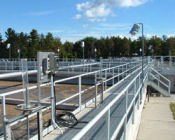
|
a |
|
- |
|
- |
|
- |
| careers |
|
||||||||||
|
municipal | industrial | marine & dredging | agriculture | sanitation | mining | electrical | irrigation | communications | residential | landfill | recreation | road & highway construction | geothermal heating | ventilation | hydronic | fireworks | fish farms | floating docks | culvert | pontoons | tile | material handling |
||
A Sewer System
In most urban centers, a sewer system is powered by gravity. Pipes
from each residence or building flow to a sewer main that runs down
the middle of the street. At certain points along the sewer main,
a vertical pipe will run up from the sewer main to the street surface,
where it can be accessed for maintenance via a manhole cover. Each
sewer main flows into larger pipes until they reach the wastewater
treatment plant. In order for gravity to its thing, the wastewater
treatment plant is usually located in a low lying area.
Sewer Pipe For Sanitation Systems
It is no secret that sanitary
and sewer systems across the world are obsolete and in a serious
state of neglect. At Oxford
Plastics, we believe that piping is a big part of the problem -
and also the solution. As we see it, piping is literally the artery
through which water is supplied and then discharged. The problem
is that most sewage systems use a piping material that is easily
corroded, hard to handle and difficult to repair or replace. Polyethylene
pipe promises to be a long-term and cost effective solution to this
problem. It is well suited for a wide range of sewage applications
in all sorts of circumstances. Its inherent physical characteristics
make it impervious to the extremely aggressive and corrosive materials
associated with sewage systems. Polyethylene
plastic pipe is light weight, flexible, durable, corrosion resistant
and leak tight making it easier to install than any other pipe material.
These features and its exceptional flow rate make it ideal for transferring
extremely aggressive materials and will greatly reduce pumping and
treatment costs.
Why Use Hdpe Pipe for Sewer and Sanitation
Systems
The biggest concern facing communities with a deteriorating sewage
system is the cost of installation and surface disruption. The installation
or rehabilitation of a sewer system main can be significantly faster
and easier with hdpe pipe. This is primarily due to the pipe's lighter
weight, ease of handling, and its suitability for trenchless technologies
like pipe bursting or horizontal directional drilling. Because of
its flexibility, hdpe pipe can be shaped during its installation
to curve around obstructions and angles with little difficulty.
Its light weight allows you to pull long assembled lengths of the
pipe through long difficult tunnels under roads and structures with
little effort at greatly reduced costs. These benefits and many
others make it a serious contender as a sewage piping solution.
If you are thinking about making a long term investment in a sewage infrastructure system for your town or city, let our experience with sewage piping applications help you to make the right decision for all concerned.
Contact
us today by email or our toll free number:
sales@oxfordplasticsinc.com
1.800.263.0502
|
Copyright ® 2003 - 2008 | Oxford Plastics Inc. | All Rights Reserved |
|||
|
Oxford Plastics Inc. ~ PO Box 119, Oxford Road 6, Embro, Ontario, CANADA, N0J 1J0 |
|||
|
Office: 519.423.6232 ~ Fax: 519.423.6057 ~ Toll Free: 1.800.263.0502 |
 Sewer
Pipe for Sanitation Systems
Sewer
Pipe for Sanitation Systems